The Definitive Shure KSM9 Review
Stunning sound quality and total flexibility for your live vocals

Reviewed by: Paul Narang
Review date: October 2022
Current price: Around $500
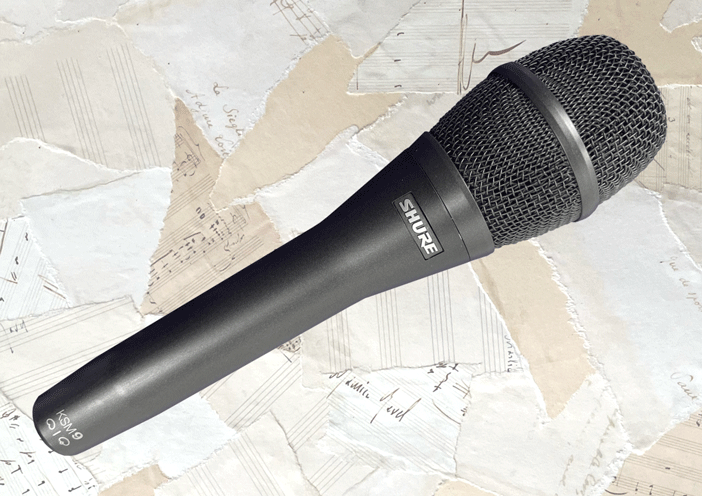

Shure KSM9 Review
| Pros: | Cons: |
| Accurate reproduction Switchable cardioid/super-cardioid Good noise rejection Clear, detailed sound | Expensive Unsuited to very loud stage environments (heavy rock/metal) |
Shure KSM9 Review
A premium-range handheld condenser vocal mic with a clear and authentic sound. This mic offers dynamic lows, balanced mids and sparkling highs.
This mic has all the detail and nuance that you’d expect from a studio condenser. But with good noise-handling and clever engineering, the KSM9 brings all of these qualities to the stage. A perfect choice for precise, intimate live vocals.
What is it?
Shure are one of the industry leaders in vocal microphones. They’re probably best-known for their affordable handheld dynamic stage microphones. And of these, the SM57 and SM58 are industry-standard around the world.
Both the SM57 and SM58 are favoured for their workhorse-like reliability and durability. However many singers and sound engineers find themselves needing to upgrade to something a bit more hi-fi.
Enter the Shure KSM9 – a condenser mic for the live stage.
Shure describe the KSM9 as “the first-ever handheld condenser with dual diaphragms and switchable polar patterns”.
It’s a departure from their simply constructed dynamic live mics. Condenser mics are more often found in the studio, where they have the ability to capture small dynamic changes and high-frequency detail.
The KSM9 also switches between cardioid and supercardioid polar patterns, so it can easily adapt to different live environments and singing styles.
An internal shock mount offers the kind of durability you’d expect from a live mic. So if you need that extra sparkle and clarity to give your live sound the edge, then this could be the handheld condenser for you.
Also in the Shure KSM series
- Shure KSM9HS
A very similar mic to the KSM9. It switches between hypercardioid (super-directional) and sub-cardioid (super-wide) patterns.
- Shure KSM8
A dynamic cardioid version of the KSM9, using the same dual-diaphragm technology. More about the KSM8 here
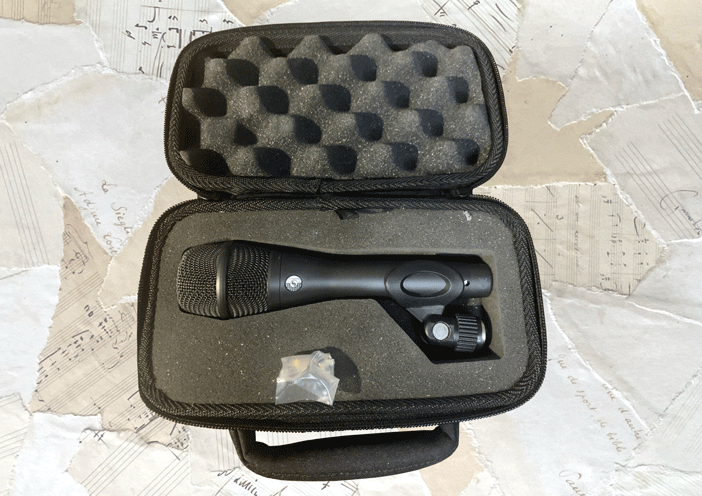
In the box
As well as the microphone, the KSM9 also comes with:
- Zipped rigid carrying case
- Stand adapter
- 5/8″ to 3/8″ thread adapter
Dynamic vs condenser microphones
Dynamic mics are extremely durable, and can withstand a certain amount of rough and tumble. The robust mechanism means they’re also less sensitive to distortion from high sound levels.
However, the weight of the coil limits how responsive the mic can be, and it tends to struggle to replicate high frequencies and dynamic detail.
Dynamic mics are particularly suited to live and stage use.
On the other hand, condenser mics are less sonically limited than dynamics, and can deliver a lot of detail and clarity. Their ability to reproduce sound so accurately is why they tend to be used in studio recording.
Condensers offer a higher output level than dynamic mics, but they’re a lot more sensitive to loud noises, handling noise, and tend to break more easily.
I think it’s fair to say, condenser mics are generally most at home in the recording studio.
Finally, dynamic mics are ‘passive’ meaning they don’t require any power. Whereas condenser mics are ‘active’ meaning they need something called power ‘phantom power’.
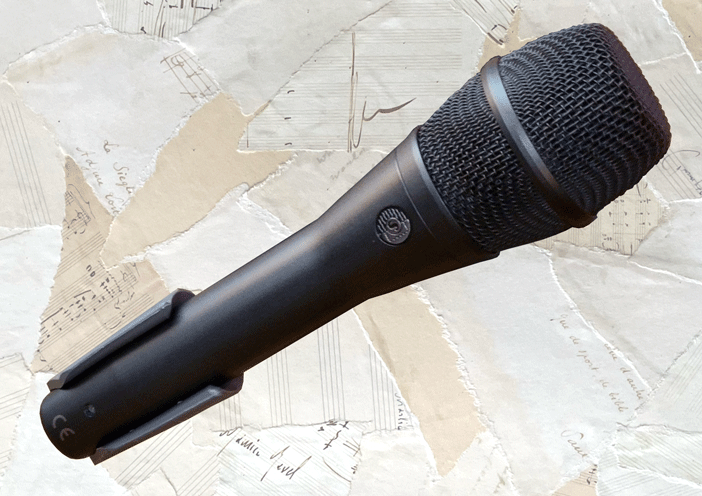
Condenser microphones for stage use
Given the sensitivities of condenser mics, why would anyone risk using one on stage?
Firstly, good live condenser mics, such as the KSM9 have internal shock mounts. This protects the diaphragm and capsule from harm, and reduces handling noise and stage vibrations.
With this taken care of, there’s many advantages to using a condenser mic. Ultimately they often sound better. Condensers offer a brighter, more detailed sound, which is more faithful to the human voice.
A good condenser will give any vocalist the air and sparkle required to effortlessly cut through the mix.
But as condensers are more sensitive than dynamic mics, they may not be the best choice for everyone. Loud rock/metal bands will probably prefer the resilience of a good dynamic mic.
Though many singers and softer styles of music will benefit from the extra detail and clarity of a condenser. Singers with quieter voices will find that a live condenser mic can better convey the emotion and intimacy of their performances.
This can really work well for folk, jazz and classical styles.
Shure KSM9 Dual Polar patterns
The Shure KSM9 can switch between two different polar patterns: cardioid and super-cardioid. This is like having two mics in one, and is a real bonus.
A cardioid polar pattern picks up sound in a heart shape around the front of the microphone. It’s most sensitive ‘on-axis’ (at 0 degrees), but also picks up sound around 65 degrees either side of the mic. A cardioid polar pattern shouldn’t pick up any sound from the rear of the microphone.
A supercardioid pattern is a little tighter around the mic, picking up sound around 57 degrees each side of the mic. However, there is a small amount of sensitivity at the rear of the mic (called a rear lobe).


On stage, the wider cardioid pattern is more suited to singers who move around the mic a bit more. It can also be a bit more forgiving when it comes to microphone technique.
But for noisy stage environments, a supercardioid pattern does a better job of rejecting noise from monitors and other instruments.
In the studio, a cardioid mic is probably all you need in a well-isolated vocal booth. But a supercardioid pattern would be better when recording a full band in a single room.
Some sound engineers also favour the increased directionality of a supercardioid when recording drums or other instruments.
No on/off switch on the Shure KSM9?
There’s no on/off switch on the KSM9 or any of the Shure KSM range.
Pro-level mics often don’t have on/off switches, because it make it less likely that the singer will accidentally turn off the mic mid performance. The sound engineer will normally mute the mic from the mixing desk when needed.
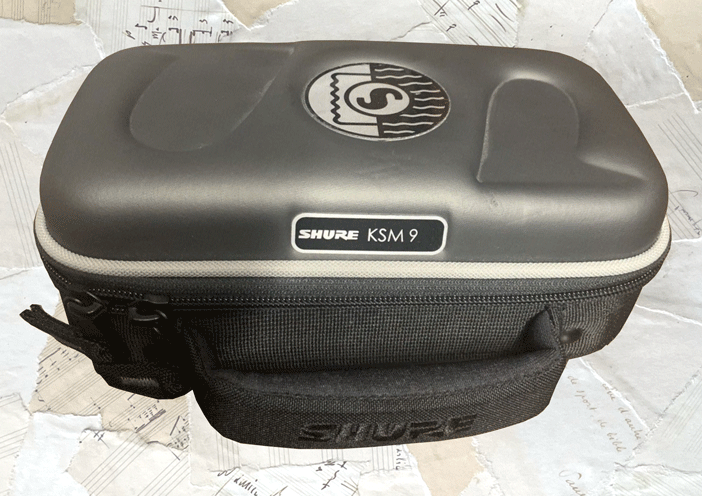
Phantom power for the Shure KSM9?
As a condenser mic, the Shure KSM9 requires phantom power. This is a small, low voltage current sent to the microphone from a microphone preamp, mixing desk, or audio interface.
Most industry standard desks or interfaces are capable of providing phantom power, which is sent through the XLR cable to the microphone. If your audio interface or mixer doesn’t provide phantom power, there is a solution: You can connect your mic to an external 48 volt phantom supply. Then connect the output of the phantom supply soundcard.
The standard voltage for phantom power is 48 V DC. The Shure KSM9 runs best at this voltage, but can perform at voltages as low as 11 V DC.
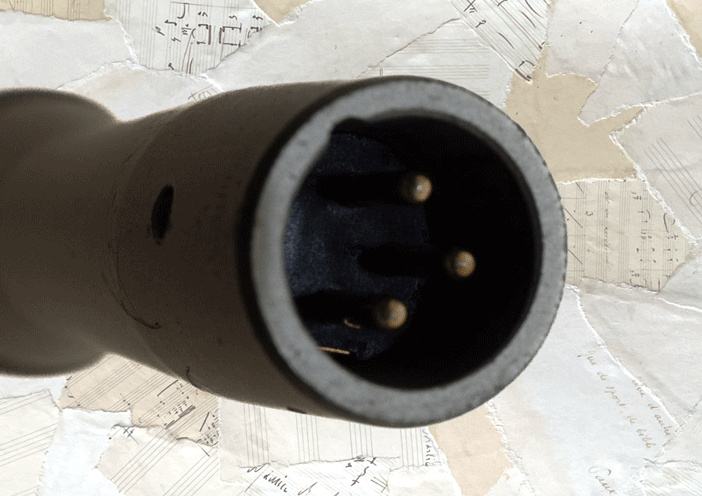
Connecting the Shure KSM9
The KSM9 uses an XLR cable to connect directly to the audio interface or mixer. XLR are the standard connectors on all professional studio equipment. They’re ‘balanced’, which means the cables are shielded from interference and carry a higher signal than unbalanced cables.
XLR cables are the only cables capable of carrying phantom power to the mic.
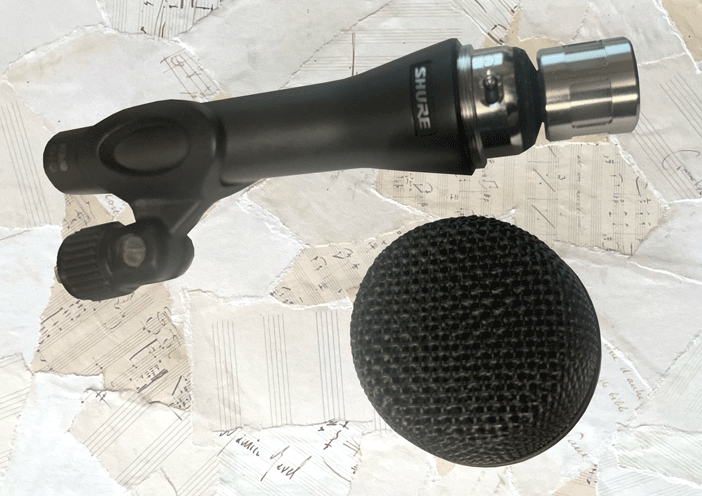
The Shure KSM9 Design and Build
The Shure KSM9 has a sleek metal solid-colour design. It’s similar in design to the classic Shure SM58, but with a squarer grille at the head of the microphone.
It features a cast aluminium handle, solid construction, and comes in two colours: charcoal or champagne. I think the champagne looks very chic!
The casing has an integrated three-state “pop” protection grille, which acts like a pop-shield and reduces plosives, breath and wind noise.
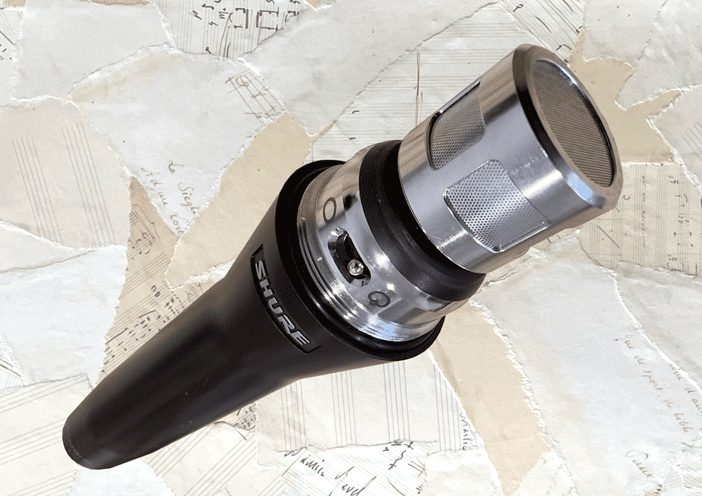
Inside, the microphone features a Class A, transformerless preamplifier circuit. This provides a clean and transparent sound, while generating a little more heat than other designs.
A dual-diaphragm design helps to reduce the proximity effect, and evens out the frequency response throughout the vocal range.
A subsonic filter helps cut out any rumble from mechanical vibrations below 17Hz. These are the vibrations in the sub bass range that you’ll feel more than hear.
Crucially for a live condenser, there’s also a suspension shock mount. This helps reduce handling and stand noise, as well as offering some protection to the internal circuit.
All in all the KSM9 has a durable, carefully considered design.
Shure KSM9 Dimensions and Weight
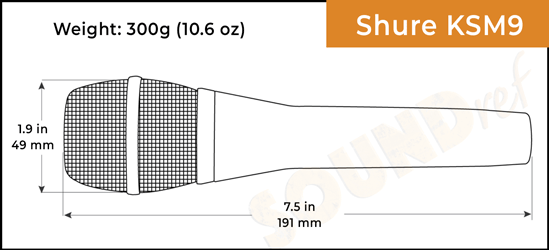
The Shure KSM9 is a fairly standard size and weight for a handheld stage mic. The head of the mic is 49 mm (1.9”) and it weighs in at about 300g (10.6oz).
At 191 mm (7.5”), it’s slightly longer than the Shure SM58. But with solid construction, the mic feels nice and sturdy to hold, without feeling overly large.
Shure KSM9 Frequency response
The KSM9 boasts a wide frequency range from 50 Hz to 20,000 Hz. This is wider than most handheld dynamic mics, and is one of the main perks of using a condenser mic. For comparison – the SM58 only reaches 15kHz.
This mic has a very flat and even range through the mids, before gently climbing through the high range from about 3kHz. This extended high range will give your vocals that extra sparkle and clarity, and a more open authentic sound.
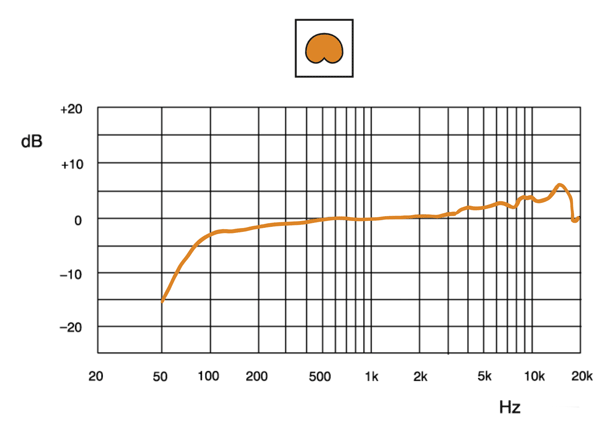
The chart is fairly even, with no big peaks or troughs apart from a little dip around 7kHz. It’s not something I could actually hear.
In the low range, we see a very gentle roll-off from 500Hz and below, with a sharper curve below 100Hz. This helps maintain richness and definition in the bass, without it becoming overwhelming. It also helps to counteract the proximity effect.
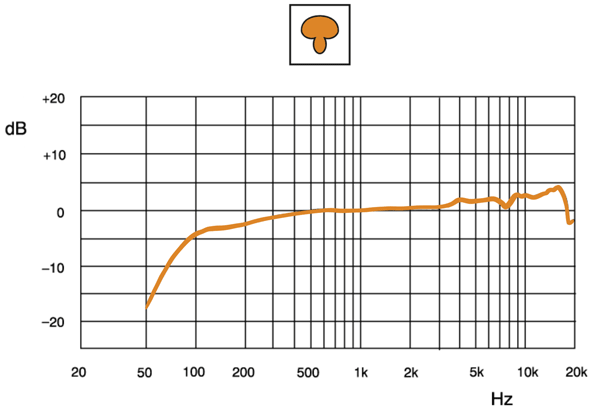
One other thing to note is that there’s a very slight difference in the high-end response between the two switchable polar patterns. If you experiment you may find you prefer the sound of one over the other, though the differences are quite small.
Shure KSM9 Sensitivity and Impedance
Like most professional microphones, the KSM9 has a low impedance of 150 ohms. This ensures a smooth transfer of the signal from the microphone to the pre-amp, without any loss of signal quality.
Most studio condenser mics are far more sensitive than dynamic mics, which can cause problems in live performance.
High sensitivity condenser mics are very good at picking up detail (both close-up and at a distance). This is great for recording ambiences, or in a controlled environment like a recording studio.
However, if you imagine a noisy gig environment, you can see how you might run into problems with feedback and monitor bleed. And let’s hope you’re not positioned next to the drum kit!
Another drawback of sensitive microphones is that they often have a low maximum SPL. This means they’re prone to overload and distortion from louder singers.
However, the KSM9 has this covered. It’s a little more sensitive than a dynamic mic like the Shure SM58, but a far cry from the high sensitivity of some studio condensers such as the AKG C414.
A max SPL of 152db is also a little lower than the SM58, but not drastically different to some of the other pro-level dynamic microphones (e.g. the Telefunken M80).
All in all, the KSM9 offers a very happy medium. You won’t have the super resilience of a dynamic mic. But this mic is well constructed, and perfect for live performances which require that superior condenser sound.

Shure KSM9 Sound quality
For many live situations, a decent dynamic mic may be ‘good enough’. They’re reliable, and lots of them sound great. However, some singers will need more control over the way their voice sounds.
If you want your live vocals to be closer to your refined studio sound, then this is where a good handheld condenser comes in.
With a decent sound system, the KSM9 is startlingly clear and detailed. It has a sumptuous rich low end that isn’t overpowering, smooth mids, and sparkling fizzy high notes.
This mic is highly dynamic and nuanced, making it the perfect mic for intimate folk, jazz or spoken word performances.
The best way I can describe the sound of the KSM9 is that it provides an authentic reproduction of the sound source. Given all the limitations of live performance, this mic really is impressively close to the natural sound of the human voice.
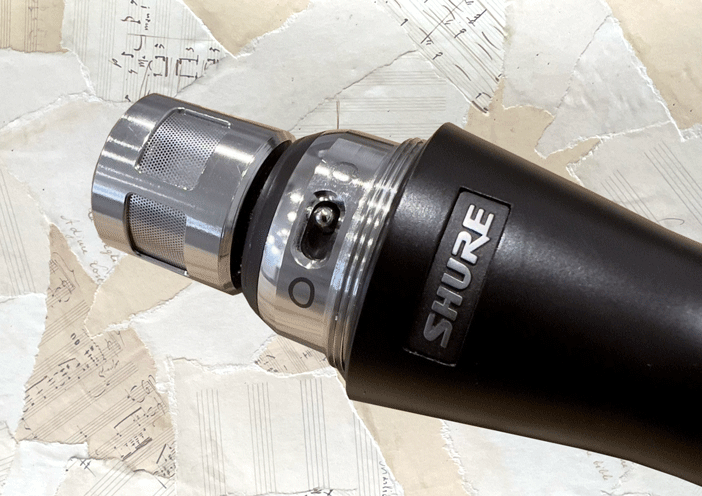
Shure KSM9 in Performance
The Shure KSM9 is a great choice as a live mic. Despite being a condenser, the design is well adapted to gigging.
The switchable polar pattern means it’s versatile, and can easily adapt to your situation.
For quieter, well-controlled stage environments, (or in-ear monitors) the cardioid pattern sounds great. This pattern is fairly forgiving of mic position and technique, whilst capturing detail.
For noisier setups, the tighter supercardioid pattern does a good job of rejecting off-axis noise, which reduces feedback and stage bleed. This might also be a good setting for backing vocals, to get more separation between neighbouring singers
The triple grille pop-shield handles plosives well, whereas the dual diaphragm design is very effective at reducing the proximity effect. This means an even, predictable low-end as the distance from the mic changes.
And crucial for live use, the built-in advanced suspension shock mount offers good insulation from handling noise and rumble.
But a mic like this isn’t perfect for all situations.
A loud metal band might struggle with the increased sensitivity of a condenser, and a raucous singer might push the limits of the mic. With these scenarios aside, many vocalists will find that the KSM9 inspires confidence on stage. There’s nothing quite like knowing your audience are listening to a high quality sound.
Shure KSM9 vs Shure KSM8
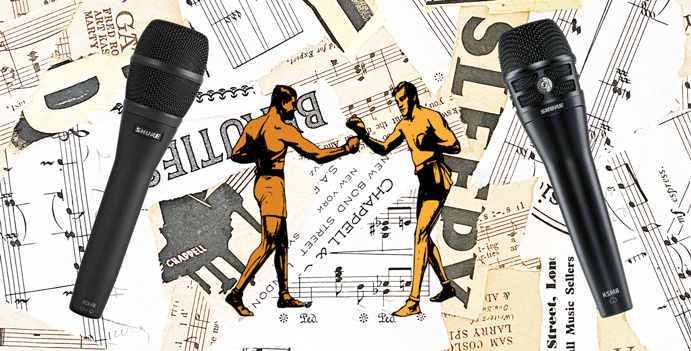
The younger sibling of the KSM9 is the Shure KSM8. On the surface this mic looks very similar, with the same sleek design. Both mics share some internal design features too: they both have the dual diaphragm design, which delivers a nice smooth frequency response.
But there’s one major difference between these two mics. The KSM8 is a dynamic mic, whereas the KSM9 is a condenser. This makes them very different types of mic, each with their own internal circuitry.
The KSM8 has many unique design quirks to reduce plosives and the proximity effect, and enable a smooth natural sound.
Another big difference between the two mics is that the KSM8 has no switchable polar pattern – it’s simply a cardioid mic.
When comparing the sound of the KSM9 vs KSM8s, I found them both to have a great sound. The KSM8 really is impressive for a dynamic mic. However the KSM9 is noticeably cleaner and brighter.
The KSM8 has more of a presence peak in the upper mids, whereas the KSM9 feels more transparent throughout the high range. The latter also feels more nuanced and detailed in its response.
The KSM8 retails for a couple of hundred dollars cheaper than its condenser counterpart, and is aimed at a slightly different consumer bracket. In my opinion, if budget allows, stretch to a KSM9.
Shure KSM9 vs Neumann KMS105
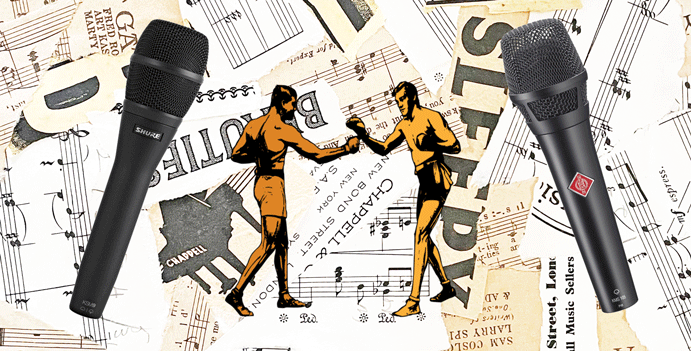
The Neumann KMS105 is another live handheld condenser mic. At a similar price, there’re many comparisons to be made between the 105 and the KSM9.
Neumann are known for producing premium quality microphones, and so it’s no surprise that the KMS105 gives the Shure KSM9 a run for its money.
Both mics have very similar specs and a similar size, weight and design.
One big difference is that the Neumann doesn’t have a switchable polar pattern – it’s a fixed supercardioid. The Neumann is also slightly more sensitive than the Shure, but it does have a similar max SPL.
A built in high pass filter on the KMS105 ensures the mic doesn’t suffer too much from the proximity effect, although I’d say the KSM9 is slightly better at feedback rejection.
On first listen, the two mics have a similarly clear and transparent sound. But on closer inspection, each mic has their own distinct but subtle character. It’s one of those things that comes down to personal taste.
It’s certainly worth testing them yourself if you can, but for my money the Shure has a slightly brighter, clearer sound through the high mids and top end.
Shure KSM9 vs Sennheiser E965
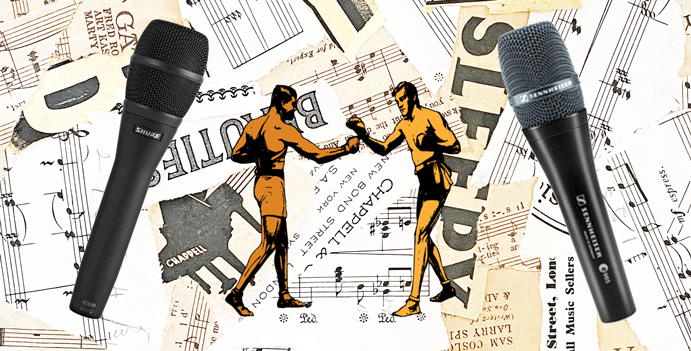
Perhaps the closest competitor to the Shure KSM9 is the Sennheiser E965. They’re both handheld condenser mics optimised for live performance
Both the KSM9 and E965 have in common:
- Switchable cardioid and super-cardioid patterns
- Similarly smooth frequency responses
- A gentle roll-off at the low end
- A subtle boost in the high end
They even look similar, with tapered handles and squareish divided metal grilles. But there are some differences.
The Sennheiser has some unique features: a low-cut filter switch, for singers who need to remove low frequency noise from the room. It also has a -10db pad which can be switched on if a vocalist needs a little less sensitivity.
The Sennheiser also has a slightly larger diaphragm than the Shure. Large diaphragm mics tend to be better at capturing low-end, whereas smaller diaphragm microphones do a better job with higher frequencies and transient detail.
Another advantage of mics with a smaller diaphragm is that they have a more controlled, consistent pickup pattern.
Ultimately the Shure KSM9 and Sennheiser E965 are two very similar microphones. I think the Shure is a little brighter in character, whereas the Sennheiser is a bit more pronounced in the low-mids.
It’s worth noting that the E965 is a bit cheaper than the KSM9. But the Shure’s smaller dual diaphragm design may give it the edge when it comes to a natural, clear and authentic sound.
Holding the Shure KSM9
Where you hold the microphone in relation to your mouth can make a big difference in sound. Professional vocalists are always repositioning their mics to change the tone and add expression to their performance.
Always hold the vocal mic by the main body, and if there’s too much sibilance, try holding it slightly to the side.
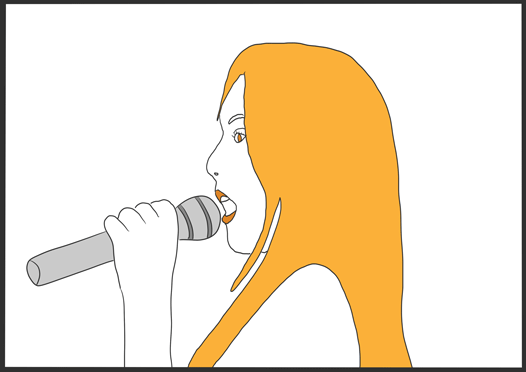
When you have other instruments in close proximity and you just want the sound of the voice, it’s best to sing or speak directly into the mic. This will add more bass to the sound, due to the ‘proximity effect’. It’s an effect used by radio presenters to give them very deep voices.
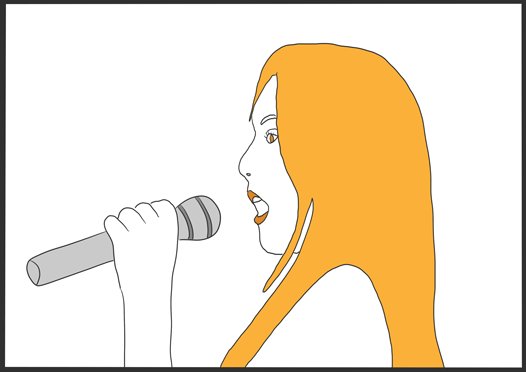
For a more natural, balanced sound, hold the mic between 5 and 10 cm away from your mouth. There’ll be less of the proximity effect, and the mic will pick up more sounds from other instruments, and the acoustics of the room.
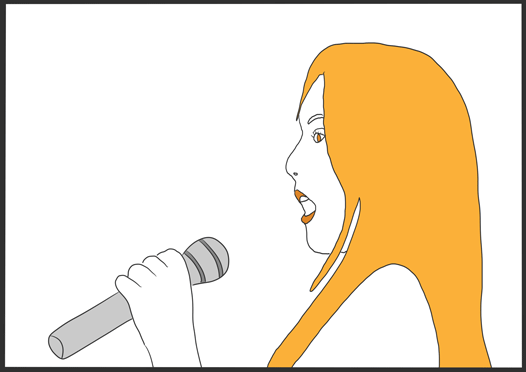
To bring in more of the room sound, and the instruments around you, hold the mic 10 cm or more away from your mouth. This is also a good position for any sudden loud notes, or to shape, and tail off a long note.
What else do you need?
With any vocal microphone, you’ll need:
- Microphone stand
Mic stands reduce any handling noise in the studio. Try a good quality boom stand, with a tripod base like the K&M 210/2
- XLR cable
If you want the best quality XLR cables, try these. Go for the shorter lengths where possible.
- Pop shield
This is to stop little bursts of air causing bassy pops on your studio recordings. You can easily make one of these out of stockings, or buy one here.
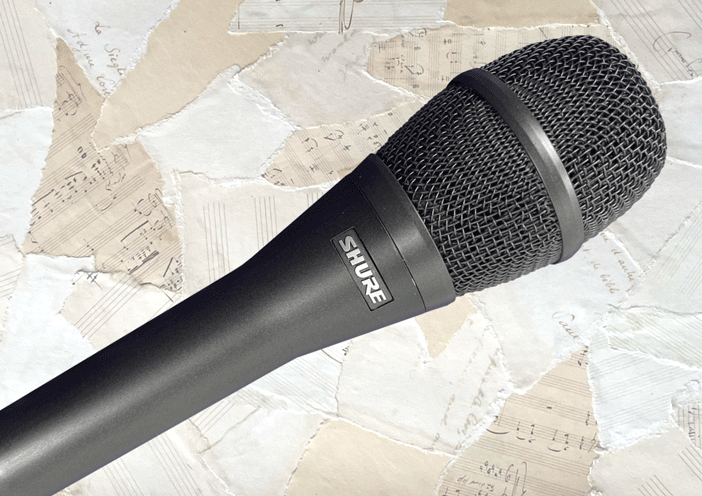
Conclusion
I can’t hide my enthusiasm about the Shure KSM9 – it’s a great live mic.
As a condenser designed for gigging and live use, the KSM9 is perfect for anyone looking to bring a high quality studio sound to the stage.
With solid internal engineering, it handles noise and feedback well. The switchable polar pattern also gives you that extra control to tailor your sound to the vocalist and the environment.
As a premium mic, the KSM9 is certainly pricey. But for the money, you’ll get a classy, crystal-clear sound with heaps of dynamic detail. It might be just what you need to take your sound to the next level.
Shure KSM9 Frequently Asked Questions
Does the Shure KSM9 need phantom power?
The Shure KSM9 is a condenser microphone, so it does require phantom power.
Can you use condenser mics on stage?
Condenser mics are a great choice for stage use as long as they have been designed specifically for live use. They’ll deliver a higher quality sound than dynamic mics.
Which artists use the Shure KSM9?
Artists seen using the Shure KSM9 include Neil Tennant, Damien Rice and Serge Tankian.
